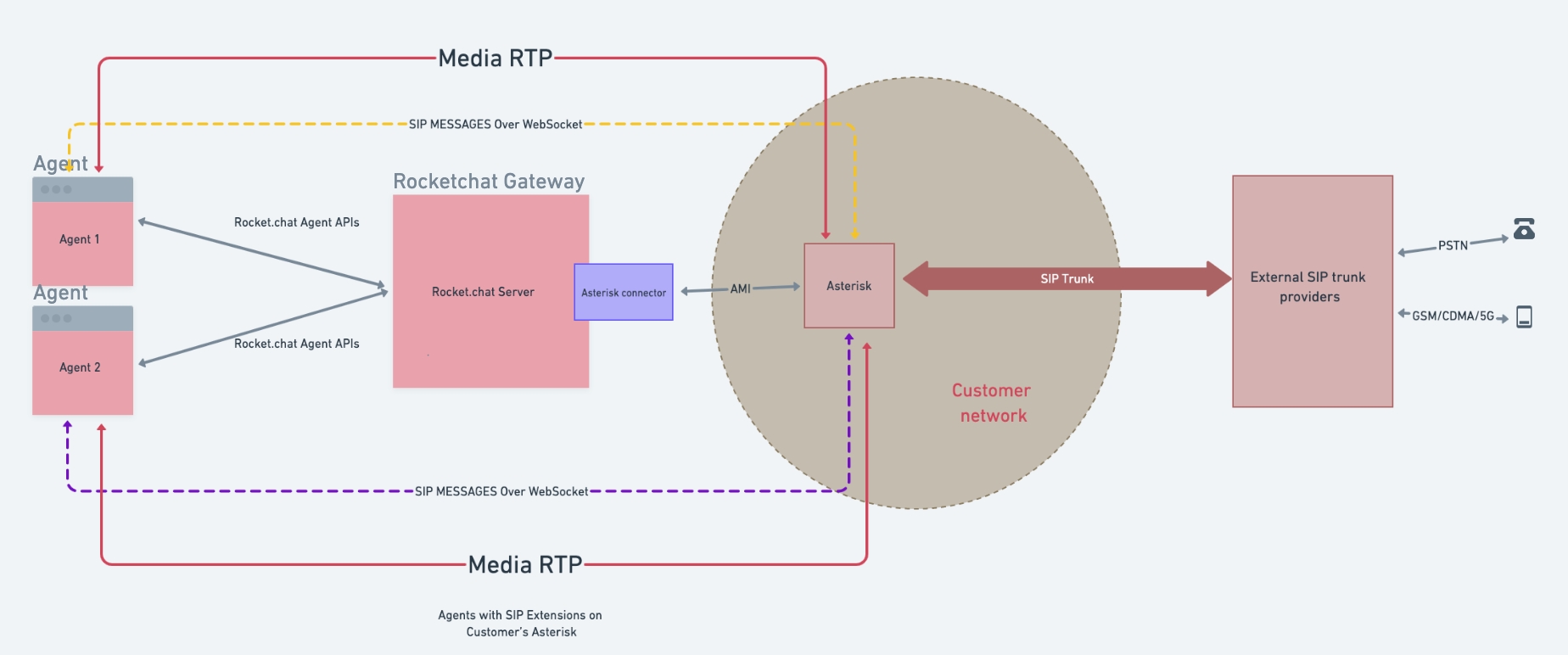Voice Channel Technical Specification
VoIP is the technology behind Rocket.Chat voice-as-channel feature.
What is VoIP?
Voice over Internet Protocol refers to the standards that facilitate voice-based phone calls using an internet connection instead of a local telephone company. Through VoIP technologies, Rocket.Chat is able to incorporate telephony-based communication protocols into its applications, promoting the transition between analog and digital technologies.
How does VoIP work?
Voice over IP converts your voice into a digital signal, compresses it, and sends it over the internet. A VoIP service provider sets up the call between all participants. The digital data is then uncompressed into the sound that you hear through your handset on the receiving end.
Why is VoIP Important for the Omnichannel environment?
In a contact center environment, Voice is an essential and influential channel. Agents using an omnichannel stack should be able to make audio/video calls to external PSTN networks, cellphone networks, and VoIP endpoints supporting SIP protocol.
Once Rocket.Chat voice-as-channel or VoIP is in place; our Enterprise Edition provides many call center features.
Rocket.Chat VoIP architecture
Here we try to describe in detail the technical and architectural aspects of bringing in a telephony protocol “SIP” on the client side in order to enable Voice calls on the platform. We also describe Automatic Call Distribution, by which the calls will be distributed to different agents.
In a contact center environment, voice is an essential and powerful channel. Agents using Omnichannel should be able to make and receive audio/video calls from external PSTN networks, cellphone networks, and VoIP endpoints supporting SIP protocol.
Web clients are built using browser-based WebRTC technology. This technology does not enforce any signaling protocol. SIP is chosen for the signaling because there are existing systems that support WebRTC over SIP, and hence there is no need to define any custom signaling protocol. Also, enabling SIP on the agent side would allow us to connect to enterprise telephony infrastructure.
Architecture
The agent connects to Opensource SIP PBX Asterisk. Using the agent configuration, an agent registers to the partner’s/customer’s SIP Server. Agent endpoint operates as any SIP endpoint and is able to receive or make a call via customer PBX.
To achieve this, there is an association made between the Rocket.Chat agent and the SIP identity.
ACD (Automatic Call Distribution) queues, wait-treatment, etc, are managed by the customer’s/Partner’s PBX. Reaching out to external networks (PSTN/Mobile Network/Another SIP Server, is handled at the customer’s/Partner’s PBX.

ACD Queues:
When Omnichannel endpoints log in as SIP agents, the problem of call distribution has to be handled. You can not expect the customer to know the agent’s identity. If they happen to know the agent's identity, there is a possibility of multiple customers trying to reach the same agent. This can increase the abandonment rate (As a particular agent will remain busy serving). Which can reduce the overall effectiveness of the agents in the organization (As some agents will always be busy, and some will be relatively free). This overwhelms the agents because of the activity on their console. A typical call center solves this problem by using ACD (Automatic Call Distribution queues).
Agents are partitioned into different queues on the PBX. These queues represent different departments in the organization. The customer does not dial the agent’s number. They dial the ACD number, and ACD forwards the call to the available agent based on the algorithm being used.
PBX Connectors:
Admins and managers use Rocket.Chat's UI to configure and monitor the customer-managed PBX. To receive real-time PBX events, Rocket.Chat’s backend has to connect to the PBX manager interface. The customer is responsible for creating the configuration on PBX so that the management APIs/interface is accessible from Rocket.Chat’s backend.
